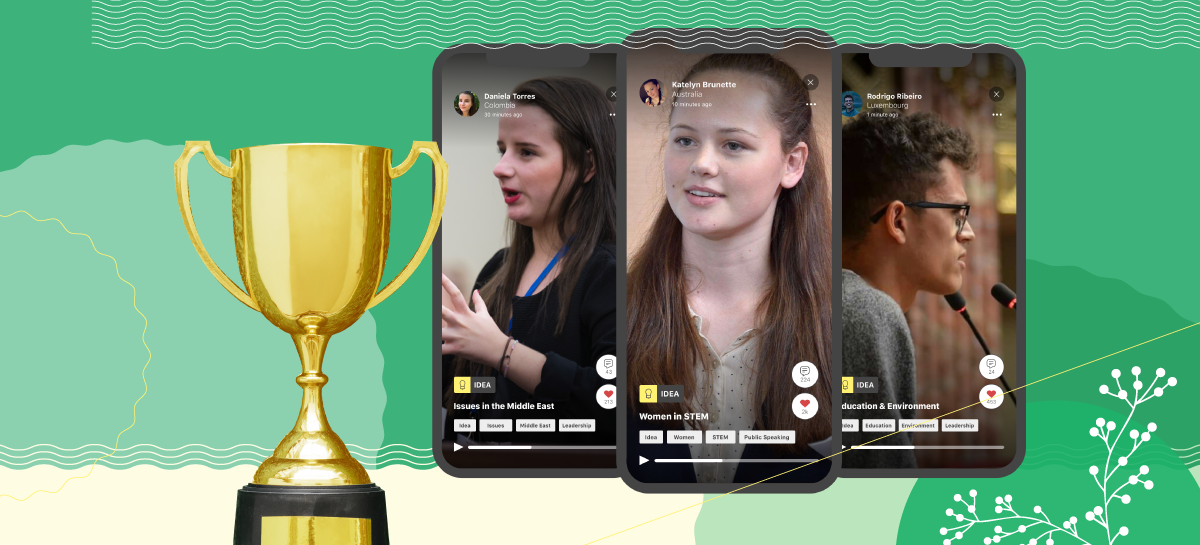July 2020 Big Update: We have ourselves a winner!!! 👏🎉
(You can read the original post below this update.)
There were many great ideas pitched on Goodwall for the 2019 Good Idea Competition, but, alas, there could only be one winner.
A big congratulations to Christina El Khoury from Jounieh, Lebanon for her idea for “Triple A,” or the “AIDS Awareness Association!”

Want to showcase yourself in the best way possible to future employers or universities? Sign up to Goodwall!
- Develop skills & experience
- Highlight accomplishments
- Network globally
- Find top jobs & internships
Download the app now to get started!
You can watch her pitch here:
Christina’s winning post was recently followed by another, where she announced that she would donate her $1,000 award to a Lebanese organization called the Autism Awareness Association:
As she says in her post:
“Very happy to announce that I have won the HIV Innovation Challenge! I will be donating the monetary award to my favorite NGO in Lebanon “Autism Awareness Association”. Always voice and share your ideas, we, the youth, are the future and change makers of our countries! I dedicate this award to my beautiful and resilient Lebanon! This award really is a beacon of hope amidst very dark times! A million Thank yous for all your support and thank you GOODWALL for giving us a wonderful platform to share our ideas!”
We are very proud of you, Christina, and we can’t wait to see what you come up with next!
Christina had some tough competition, though, and we’d like to also give a quick shout out to the two runner-ups in the 2019 Good Idea Competition.
In second place was Denys Andrushchenko from Cherkasy, Ukraine with his idea for the KarmaTime app, where users earn points for completing tasks that help the SDGs! You can see his pitch here:
And coming in just behind Christina and Denys is Shubham Rathore from Gurugram, India. Shubham came up with a small windmill design concept which could generate electricity while taking up a very small footprint; it’s quite impressive, to say the very least! Here’s his pitch:
Way to go, Denys and Shubham!
Here’s the original post:
The 2019 Good Idea Competition is open for entries, and we’ve got 1,000 reasons for you to participate!
We’ve just released a new feature, the “virtual elevator pitch,” a platform to share your ideas as 30-second vertical videos with the global Goodwall community. Because we want to encourage idea-sharing, we’re hosting a contest to award the most innovative idea shared via the app.
The winner receives the 2019 Good Idea Award—complete with a $1000 prize!
Along with the University of Geneva and the Geneva Tsinghua Initiative, Goodwall is hosting this competition to support Global Entrepreneurship Week. While GEW takes place from November 18–24, 2019, we’re keeping this contest open until December 31, 2019.
You’ve got until the end of the year, but there’s no better time than the present to get your idea out of your thoughts and into the world. We can’t wait to see what you come up with!
Prize
One winner will receive a $1000 prize upon being voted by the community and a panel of judges to have pitched the most innovative idea.

But, that’s not all!
This winner pitched 2019’s greatest idea, and we want to make sure it gets the recognition it deserves. So, we’ll be featuring them on our website and across social media to help their idea get the visibility, traction, and support it needs to transform into an actuality.
On top of that, the winner will have the opportunity to connect with a variety of influential people who could help them take their idea to the next level. Potential investors, mentors—even your next possible partner or cofounder—are right around the corner.
How to Participate
Here’s how to participate in the 2019 Good Idea Award:
Step 1: Pitch your most unique, groundbreaking, world-changing idea as a vertical video through the Goodwall app.
Step 2: Share your 30-second virtual elevator pitch (like a traditional elevator pitch, but in video and much more powerful) publicly to the Goodwall community.
Step 3: The community will vote on the 25 most innovative ideas, and each of these finalists will receive a certificate for their accomplishment.
Step 4: A panel of judges will decide from among the 25 finalists which idea was the most powerful and inventive.
Step 5: That idea wins the 2019 Good Idea Award!

Eligibility Requirements
Here are answers to a few frequently asked questions (FAQs) about the Good Idea Award:
Any idea is eligible. The only criteria are that it solves a problem or improves something. The problem could be big or small, from climate change to choosing lunch.
The 25 finalists will be selected by Goodwall’s community. Every like an idea receives counts as a vote. Goodwall may also offer a couple of wildcards for ideas we feel are powerful but did not get enough votes. The winner will be selected by Goodwall’s jury.
Everyone on Goodwall’s community. The ideas may also be shared by Goodwall on social channels to increase their reach.
The ideas are owned by the individual who came up with the idea. It is possible for example to pitch someone else’s idea, too.
The deadline for pitching ideas to win the Good Idea Award is December 31, 2019.
Last but not least, have fun! Be creative with your ideas, think outside the box, and don’t be shy. You don’t need to be an entrepreneur or a president, all you need is an idea and the courage to pitch it.
The world can always use another good idea—why not yours?
Check out our posts on why you should pitch ideas on Goodwall and how to pitch ideas on Goodwall. If you need inspiration, we’ve got dozens of encouraging quotes for entrepreneurs. Finally, leave a comment below, and thanks for reading!




Hi, Christian! Any updates on this challenge? Thank you before.
Hi Adriana! So sorry for the delay, but I just updated the post with our winner!
Hi Adriana, thanks for writing in! Once again, I apologize for the lengthy delay, but I brought it up once again today and Omar has assembled a jury to weigh the responses! So, fingers crossed, but I expect quite soon now 🙂
Hi, Christian. Any news yet?
Stay home. Stay strong.
Hi Denny, sorry about the delay. I just asked Omar, they’re going to update me soon!
Hey, are there any updates on this competition?
Hi Denny, thanks for writing in! Right now, they’re still tallying the results, but I’ll update this blog post as soon as I get the answer!
You can develop it by offering the greatest jobs in ads for people and in the same time offer the greatest profiles for the companies then you would connect between both and when it successes the other people will know about the people who accepted in amazing job then the new ones will start to sign in and it will increase and it will achieve a massive success in goodwall and thanks
Thanks for your idea, Mahmoud! Would you pitch your idea as a 30-second video on the app?